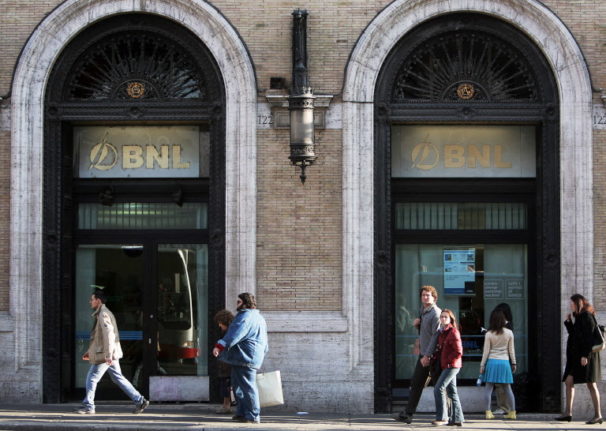Families in Italy can now request the new single universal child benefit (L’assegno unico e universale) since applications opened on January 1st, 2022.
The new single allowance, approved in November, replaces a range of so-called ‘baby bonuses‘ in a move hoped to simplify the process of claiming financial support for parents.
READ ALSO: Ten things you need to know about giving birth in Italy
Some seven million families in Italy are eligible to claim the new benefit, and 1.75 million requests have already been made, according to data from Italy’s Social Security Institute (INPS).
For those yet to apply, the INPS on February 9th published instructions on making a claim – currently only in Italian.
Based on the official information available, here’s a guide to what the allowance is, who’s eligible, and how to apply.
What is the single universal child benefit?
The new allowance is a monthly means-tested benefit for those who have children, or are about to have a child.
It is payable from the seventh month of pregnancy until the child reaches the age of 18 or in some cases, 21.
The first payments will be made in March 2022. If you apply by June, you’ll receive payments in arrears from January. After this date, you can still apply but won’t receive any backdated payments.

It’s also available to parents of children between 18 and 21 years of age who are dependent on the family – but they must prove that the child has undertaken a course of study or training, or has started an apprenticeship or traineeship contract.
No age limit is imposed in the case of a disabled child.
The universal payment is intended to help encourage more people in Italy to start a family as the birth rate slumps again to a new record low.
It comes as part of the country’s wider strategy – the so-called Family Act – which aims to make starting a family in Italy more affordable.
However, with the introduction of this payment, other ‘bonuses’ for parents have been scrapped altogether – such as the one-off payment of €800 for expectant mothers (Bonus Mamma Domani) and the Bonus Bebé, which had a higher minimum payout, available for the first year of the child’s life.
How much are you entitled to?
The amount payable to each family is based on the household’s economic situation, which in Italy is calculated as ‘ISEE’ (Indicatore della Situazione Economica Equivalente, or ‘Equivalent Financial Position Indicator’).
In other words, you are means-tested to find out how much allowance you’ll be entitled to. The calculation takes into account income and 20 percent of assets, such as your house and your car, for instance.
READ ALSO: How Italy just made it easier to access essential paperwork online
To find out what your ISEE is, you need to fill out a declaration form of your income and assets called the DSU (Dichiarazione Sostitutiva Unica). You can do this yourself or ask your accountant (commercialista) for help.
The amount you can claim ranges from a maximum of €175 per month for households with an ISEE of up to €15,000 per year, to a minimum monthly amount of €50 for those with an ISEE of over €40,000.

If you decide not to calculate your ISEE, INPS states that you’ll be entitled to the base rate of €50 monthly for each child.
From the third child onwards, there is an extra €85 per child and an extra €30 if both parents work.
That means typical payments will range from €50 per month if you have one child and have an ISEE over €40,000, or don’t submit one at all, to around €700 per month if you have three children on a minimum ISEE and both parents are in work.
You’ll need to claim again annually for this benefit.
Who is eligible to claim?
Parents or those who have parental responsibility can access this benefit regardless of employment status. That means all categories of employees (both public and private), the self-employed, pensioners, the unemployed and the unemployable are equally eligible.
Grandparents can apply in the case of sole parental responsibility.
To be eligible, you need to either be an Italian or EU citizen, or a family member of an Italian or EU citizen.
You can also apply if you are a citizen of a non-European country and have an Italian or EU long-term residence permit (permesso di soggiorno per soggiornanti di lungo periodo).
READ ALSO: Visas and residency permits: How to move to Italy (and stay here)
You can also claim the allowance if you hold a work permit authorised for a period of more than six months, or if you hold a residence permit for research purposes authorised for more than six months.
If you wish, you can split the benefit between two parents, by entering the two payment details in the application.
If you’re pregnant, you can only apply after the birth, when the child has been assigned a tax code (codice fiscale). With the first monthly allowance, arrears will be paid from the seventh month of pregnancy.
You can still claim the Bonus asilo nido (nursery bonus) concurrently.
How do I claim?
There are a few ways to apply:
- by accessing the MyINPS site here – then click on ‘Assegno unico e universale per i figli a carico‘ (Single and universal allowance for dependent children). You’ll need your SPID, a Carta di Identità Elettronica (CIE) or a Carta Nazionale dei Servizi (CNS) to log in;
- by calling 803164 (free of charge from a landline) or 06164164 (from a mobile network – charges will apply);
- by going to a patronato (a type of office offering legal and bureaucratic advice and assistance), or by asking an accountant (commercialista) for advice.
READ ALSO: How to use your Italian ID card to access official services online
For more information, INPS has created an FAQ – you can read it (in Italian) here.
The Ministry of Economy and Finance has also provided detailed information on the benefit with a breakdown of how much you can claim based on your ISEE bracket and number of children here.
See more of The Local’s guides to dealing with Italian bureaucracy here.





 Please whitelist us to continue reading.
Please whitelist us to continue reading.
Member comments